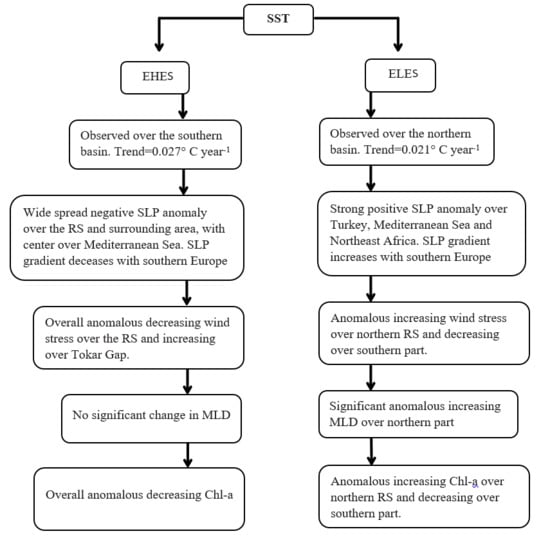Atmospheric Forcing of the High and Low Extremes in the Sea Surface Temperature over the Red Sea and Associated Chlorophyll-a Concentration
Abstract
1. Introduction
2. Datasets and Methods
2.1. Datasets
2.2. Methods
2.2.1. Extreme SST Events
2.2.2. Composite Analysis
3. Results and Discussion
3.1. Climatological Features over the RS
3.2. Spatial and Temporal EHEs and ELEs Variability
3.3. Physical Mechanisms
3.3.1. SLP
3.3.2. Wind Stress
3.3.3. The Net Surface Air–Sea Heat Flux
3.3.4. Associated MLD and Chl-a
4. Conclusions
Author Contributions
Funding
Acknowledgments
Conflicts of Interest
References
- Gobler, C.J.; Doherty, O.M.; Hattenrath-Lehmann, T.K.; Griffith, A.W.; Kang, Y.; Litaker, R.W. Ocean warming since 1982 has expanded the niche of toxic algal blooms in the North Atlantic and North Pacific oceans. Proc. Natl. Acad. Sci. USA 2017, 114, 4975–4980. [Google Scholar] [CrossRef] [PubMed]
- Ainsworth, T.D.; Heron, S.F.; Ortiz, J.C.; Mumby, P.J.; Grech, A.; Ogawa, D.; Eakin, C.M.; Leggat, W. Climate change disables coral bleaching protection on the Great Barrier Reef. Science 2016, 352, 338–342. [Google Scholar] [CrossRef] [PubMed]
- Brander, K.M. Global fish production and climate change. Proc. Natl. Acad. Sci. USA 2007, 104, 19709–19714. [Google Scholar] [CrossRef]
- Harvell, C.D.; Kim, K.; Burkholder, J.M.; Colwell, R.R.; Epstein, P.R.; Grimes, D.J.; Hofmann, E.E.; Lipp, E.K.; Osterhaus, A.; Overstreet, R.M. Emerging marine diseases–climate links and anthropogenic factors. Science 1999, 285, 1505–1510. [Google Scholar] [CrossRef]
- Bindoff, N.L.; Cheung, W.W.; Kairo, J.G.; Arstegui, J.; Guinder, V.A.; Hallberg, R.; Hilmi, N.; Jiao, N.; Karim, M.S.; Levin, L. Changing ocean, marine ecosystems, and dependent communities. In IPCC Special Report on the Ocean and Cryosphere in a Changing Climate; United Nations Environment Programme: Nairobi, Kenya, 2019. [Google Scholar]
- IPCC. Climate Change 2013—The Physical Science Basis: Working Group I Contribution to the Fifth Assessment Report of the Intergovernmental Panel on Climate Change; Cambridge University Press: Cambridge, UK, 2014. [Google Scholar]
- Trenberth, K.E.; Dai, A.; Van Der Schrier, G.; Jones, P.D.; Barichivich, J.; Briffa, K.R.; Sheffield, J. Global warming and changes in drought. Nat. Clim. Chang. 2014, 4, 17–22. [Google Scholar] [CrossRef]
- Prospero, J.M.; Lamb, P.J. African droughts and dust transport to the Caribbean: Climate change implications. Science 2003, 302, 1024–1027. [Google Scholar] [CrossRef] [PubMed]
- Ban, N.; Schmidli, J.; Schär, C. Heavy precipitation in a changing climate: Does short-term summer precipitation increase faster? Geophys. Res. Lett. 2015, 42, 1165–1172. [Google Scholar] [CrossRef]
- Berg, N.; Hall, A. Increased interannual precipitation extremes over California under climate change. J. Clim. 2015, 28, 6324–6334. [Google Scholar] [CrossRef]
- Cane, M.A.; Clement, A.C.; Kaplan, A.; Kushnir, Y.; Pozdnyakov, D.; Seager, R.; Zebiak, S.E.; Murtugudde, R. Twentieth-century sea surface temperature trends. Science 1997, 275, 957–960. [Google Scholar] [CrossRef] [PubMed]
- Collins, M.; Knutti, R.; Arblaster, J.; Dufresne, J.-L.; Fichefet, T.; Friedlingstein, P.; Gao, X.; Gutowski, W.J.; Johns, T.; Krinner, G. Long-term climate change: Projections, commitments and irreversibility. In Climate Change 2013—The Physical Science Basis: Contribution of Working Group I to the Fifth Assessment Report of the Intergovernmental Panel on Climate Change; Cambridge University Press: Cambridge, UK, 2013; pp. 1029–1136. [Google Scholar]
- Xie, S.-P.; Deser, C.; Vecchi, G.A.; Collins, M.; Delworth, T.L.; Hall, A.; Hawkins, E.; Johnson, N.C.; Cassou, C.; Giannini, A. Towards predictive understanding of regional climate change. Nat. Clim. Chang. 2015, 5, 921. [Google Scholar] [CrossRef]
- Pithan, F.; Mauritsen, T. Arctic amplification dominated by temperature feedbacks in contemporary climate models. Nat. Geosci. 2014, 7, 181. [Google Scholar] [CrossRef]
- Belkin, I.M. Rapid warming of large marine ecosystems. Prog. Oceanogr. 2009, 81, 207–213. [Google Scholar] [CrossRef]
- Hoegh-Guldberg, O.; Cai, R.; Poloczanska, E.S.; Brewer, P.G.; Sundby, S.; Hilmi, K.; Barros, V.R.; Field, C.B.; Dokken, D.J.; Mastrandrea, M.D. Climate Change 2014: Impacts, Adaptation, and Vulnerability Part B: Regional Aspects; Cambridge University Press: Cambridge, UK, 2014. [Google Scholar]
- Chaidez, V.; Dreano, D.; Agusti, S.; Duarte, C.M.; Hoteit, I. Decadal trends in Red Sea maximum surface temperature. Sci. Rep. 2017, 7, 8144. [Google Scholar] [CrossRef] [PubMed]
- Raitsos, D.E.; Yi, X.; Platt, T.; Racault, M.-F.; Brewin, R.J.; Pradhan, Y.; Papadopoulos, V.P.; Sathyendranath, S.; Hoteit, I. Monsoon oscillations regulate fertility of the Red Sea. Geophys. Res. Lett. 2015, 42, 855–862. [Google Scholar] [CrossRef]
- Alawad, K.A.; Al-Subhi, A.M.; Alsaafani, M.A.; Turki, M. Alraddad Decadal variability and recent summer warming amplification of sea surface temperature in the Red Sea. PLoS ONE 2020, submitted. [Google Scholar]
- Shaltout, M. Recent sea surface temperature trends and future scenarios for the Red Sea. Oceanologia 2019, 61, 484–504. [Google Scholar] [CrossRef]
- Roik, A.; Roder, C.; Röthig, T.; Voolstra, C.R. Spatial and seasonal reef calcification in corals and calcareous crusts in the central Red Sea. Coral Reefs 2016, 35, 681–693. [Google Scholar] [CrossRef]
- Cantin, N.E.; Cohen, A.L.; Karnauskas, K.B.; Tarrant, A.M.; McCorkle, D.C. Ocean warming slows coral growth in the central Red Sea. Science 2010, 329, 322–325. [Google Scholar] [CrossRef]
- Eladawy, A.; Nadaoka, K.; Negm, A.; Abdel-Fattah, S.; Hanafy, M.; Shaltout, M. Characterization of the northern Red Sea’s oceanic features with remote sensing data and outputs from a global circulation model. Oceanologia 2017, 59, 213–237. [Google Scholar] [CrossRef]
- Karnauskas, K.B.; Jones, B.H. The interannual variability of sea surface temperature in the Red Sea from 35 years of satellite and in situ observations. J. Geophys. Res. Oceans 2018, 123, 5824–5841. [Google Scholar] [CrossRef]
- Reynolds, R.W.; Smith, T.M.; Liu, C.; Chelton, D.B.; Casey, K.S.; Schlax, M.G. Daily high-resolution-blended analyses for sea surface temperature. J. Clim. 2007, 20, 5473–5496. [Google Scholar] [CrossRef]
- Worley, S.J.; Woodruff, S.D.; Reynolds, R.W.; Lubker, S.J.; Lott, N. ICOADS release 2.1 data and products. Int. J. Climatol. J. R. Meteorol. Soc. 2005, 25, 823–842. [Google Scholar] [CrossRef]
- Carton, J.A.; Chepurin, G.A.; Chen, L. SODA3: A new ocean climate reanalysis. J. Clim. 2018, 31, 6967–6983. [Google Scholar] [CrossRef]
- NASA Goddard Space Flight Center; Ocean Biology Processing Group. Sea-Viewing Wide Field-of-View Sensor (SeaWiFS) Ocean Color Data; NASA Ocean Biology Distibuted Active Archive Center (NASA OB.DAAC): Greenbelt, MD, USA, 2014. [Google Scholar] [CrossRef]
- Al-Subhi, A.M.; Taqi, A.M. Remotely Sensed Sea Surface Temperature Variations in the Southern Red Sea in Relation to Some Meteorological Variables. J. King Abdulaziz Univ. 2010, 21, 33. [Google Scholar]
- Al-Subhi, A.M.; Al-Aqsum, M.M. Temporal and Spatial Variations of Remotely Sensed Sea Surface Temperature in the Northern Red Sea. J. King Abdulaziz Univ. Mar. Sci 2008, 19, 61–74. [Google Scholar] [CrossRef]
- Sofianos, S.S.; Johns, W.E. Wind induced sea level variability in the Red Sea. Geophys. Res. Lett. 2001, 28, 3175–3178. [Google Scholar] [CrossRef]
- Felis, T.; Mudelsee, M. Pacing of Red Sea deep water renewal during the last centuries. Geophys. Res. Lett. 2019, 46, 4413–4420. [Google Scholar] [CrossRef]
- Sofianos, S.S.; Johns, W.E. An oceanic general circulation model (OGCM) investigation of the Red Sea circulation: 2. Three-dimensional circulation in the Red Sea. J. Geophys. Res. Oceans 2003, 108, 3066. [Google Scholar] [CrossRef]
- Al Saafani, M.A.; Shenoi, S.S.C. Water masses in the Gulf of Aden. J. Oceanogr. 2007, 63, 1–14. [Google Scholar] [CrossRef]
- Ali, E.B.; Churchill, J.H.; Barthel, K.; Skjelvan, I.; Omar, A.M.; de Lange, T.E.; Eltaib, E.B. Seasonal variations of hydrographic parameters off the Sudanese coast of the Red Sea, 2009–2015. Reg. Stud. Mar. Sci. 2018, 18, 1–10. [Google Scholar] [CrossRef]
- Al-Subhi, A.M.; Taqi, A.M. Surface Circulation of the Southern Red Sea as Inferred From AVHRR Data. J. King Abdulaziz Univ. 2014, 25, 121. [Google Scholar] [CrossRef]
- Abualnaja, Y.; Papadopoulos, V.P.; Josey, S.A.; Hoteit, I.; Kontoyiannis, H.; Raitsos, D.E. Impacts of climate modes on air–sea heat exchange in the Red Sea. J. Clim. 2015, 28, 2665–2681. [Google Scholar] [CrossRef]
- Papadopoulos, V.P.; Abualnaja, Y.; Josey, S.A.; Bower, A.; Raitsos, D.E.; Kontoyiannis, H.; Hoteit, I. Atmospheric forcing of the winter air–sea heat fluxes over the northern Red Sea. J. Clim. 2013, 26, 1685–1701. [Google Scholar] [CrossRef]
- Kontoyiannis, H.; Papadopoulos, V.; Kazmin, A.; Zatsepin, A.; Georgopoulos, D. Climatic variability of the sub-surface sea temperatures in the Aegean-Black Sea system and relation to meteorological forcing. Clim. Dyn. 2012, 39, 1507–1525. [Google Scholar] [CrossRef]
- Papadopoulos, V.P.; Kontoyiannis, H.; Ruiz, S.; Zarokanellos, N. Influence of atmospheric circulation on turbulent air-sea heat fluxes over the Mediterranean Sea during winter. J. Geophys. Res. Oceans 2012, 117. [Google Scholar] [CrossRef]
- Patzert, W.C. Wind-induced reversal in Red Sea circulation. In Deep Sea Research and Oceanographic Abstracts; Elsevier: Amsterdam, The Netherlands, 1974; Volume 21, pp. 109–121. [Google Scholar]
- Jiang, H.; Farrar, J.T.; Beardsley, R.C.; Chen, R.; Chen, C. Zonal surface wind jets across the Red Sea due to mountain gap forcing along both sides of the Red Sea. Geophys. Res. Lett. 2009, 36. [Google Scholar] [CrossRef]
- Ionita, M.; Felis, T.; Lohmann, G.; Rimbu, N.; Pätzold, J. Distinct modes of East Asian Winter Monsoon documented by a southern Red Sea coral record. J. Geophys. Res. Oceans 2014, 119, 1517–1533. [Google Scholar] [CrossRef][Green Version]
- Charabi, Y.; Al-Hatrushi, S. Synoptic aspects of winter rainfall variability in Oman. Atmos. Res. 2010, 95, 470–486. [Google Scholar] [CrossRef]
- Zubier, K.M.; Eyouni, L.S. Investigating the Role of Atmospheric Variables on Sea Level Variations in the Eastern Central Red Sea Using an Artificial Neural Network Approach. Oceanologia 2020. [Google Scholar] [CrossRef]
- Alawad, K.A.; Al-Subhi, A.M.; Alsaafani, M.A.; Alraddadi, T.M.; Ionita, M.; Lohmann, G. Large-Scale Mode Impacts on the Sea Level over the Red Sea and Gulf of Aden. Remote Sens. 2019, 11, 2224. [Google Scholar] [CrossRef]
- Alawad, K.; Alsaafani, M.A.; Al-Subhi, A.M.; Alraddadi, T.M. Signatures of Tropical Climate Modes on the Red Sea and Gulf of Aden Sea Level; NISCAIR-CSIR: New Delhi, India, 2017. [Google Scholar]
- Somavilla, R.; González-Pola, C.; Fernández-Diaz, J. The warmer the ocean surface, the shallower the mixed layer. How much of this is true? J. Geophys. Res. Oceans 2017, 122, 7698–7716. [Google Scholar] [CrossRef]
- Behrenfeld, M.J.; O’Malley, R.T.; Siegel, D.A.; McClain, C.R.; Sarmiento, J.L.; Feldman, G.C.; Milligan, A.J.; Falkowski, P.G.; Letelier, R.M.; Boss, E.S. Climate-driven trends in contemporary ocean productivity. Nature 2006, 444, 752–755. [Google Scholar] [CrossRef] [PubMed]
- Maor-Landaw, K.; Karako-Lampert, S.; Ben-Asher, H.W.; Goffredo, S.; Falini, G.; Dubinsky, Z.; Levy, O. Gene expression profiles during short-term heat stress in the red sea coral Stylophora pistillata. Glob. Chang. Biol. 2014, 20, 3026–3035. [Google Scholar] [CrossRef] [PubMed]
- Bai, Y.; He, X.; Yu, S.; Chen, C.-T.A. Changes in the Ecological Environment of the Marginal Seas along the Eurasian Continent from 2003 to 2014. Sustainability 2018, 10, 635. [Google Scholar] [CrossRef]
- Caputi, N.; Jackson, G.; Pearce, A. The Marine Heat Wave off Western Australia During the Summer of 2010/11: 2 Years on; Fisheries Research Division, Western Australian Fisheries and Marine: North Beach, Australia, 2014. [Google Scholar]
- Doney, S.C. Plankton in a warmer world. Nature 2006, 444, 695–696. [Google Scholar] [CrossRef] [PubMed]
- Triantafyllou, G.; Yao, F.; Petihakis, G.; Tsiaras, K.P.; Raitsos, D.E.; Hoteit, I. Exploring the Red Sea seasonal ecosystem functioning using a three-dimensional biophysical model. J. Geophys. Res. Oceans 2014, 119, 1791–1811. [Google Scholar] [CrossRef]
- Raitsos, D.E.; Pradhan, Y.; Brewin, R.J.; Stenchikov, G.; Hoteit, I. Remote sensing the phytoplankton seasonal succession of the Red Sea. PLoS ONE 2013, 8. [Google Scholar] [CrossRef]
- Ehsan, M.A.; Nicolì, D.; Kucharski, F.; Almazroui, M.; Tippett, M.K.; Bellucci, A.; Ruggieri, P.; Kang, I.-S. Atlantic Ocean influence on Middle East summer surface air temperature. NPJ Clim. Atmos. Sci. 2020, 3, 1–8. [Google Scholar] [CrossRef]
- Krokos, G.; Papadopoulos, V.P.; Sofianos, S.S.; Ombao, H.; Dybczak, P.; Hoteit, I. Natural climate oscillations may counteract Red Sea warming over the coming decades. Geophys. Res. Lett. 2019, 46, 3454–3461. [Google Scholar] [CrossRef]
- Shanas, P.R.; Aboobacker, V.M.; Albarakati, A.M.; Zubier, K.M. Climate driven variability of wind-waves in the Red Sea. Ocean Model. 2017, 119, 105–117. [Google Scholar] [CrossRef]

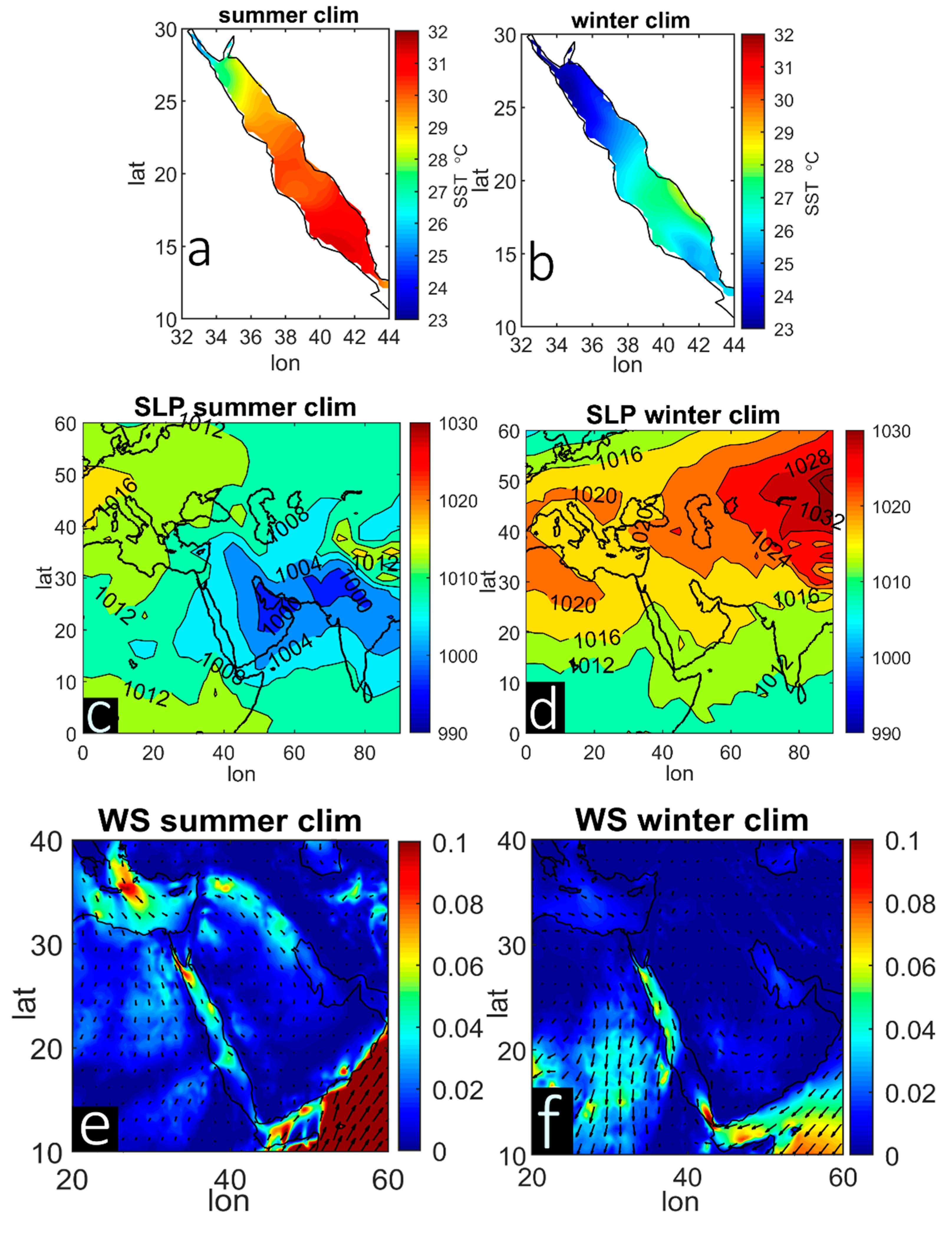
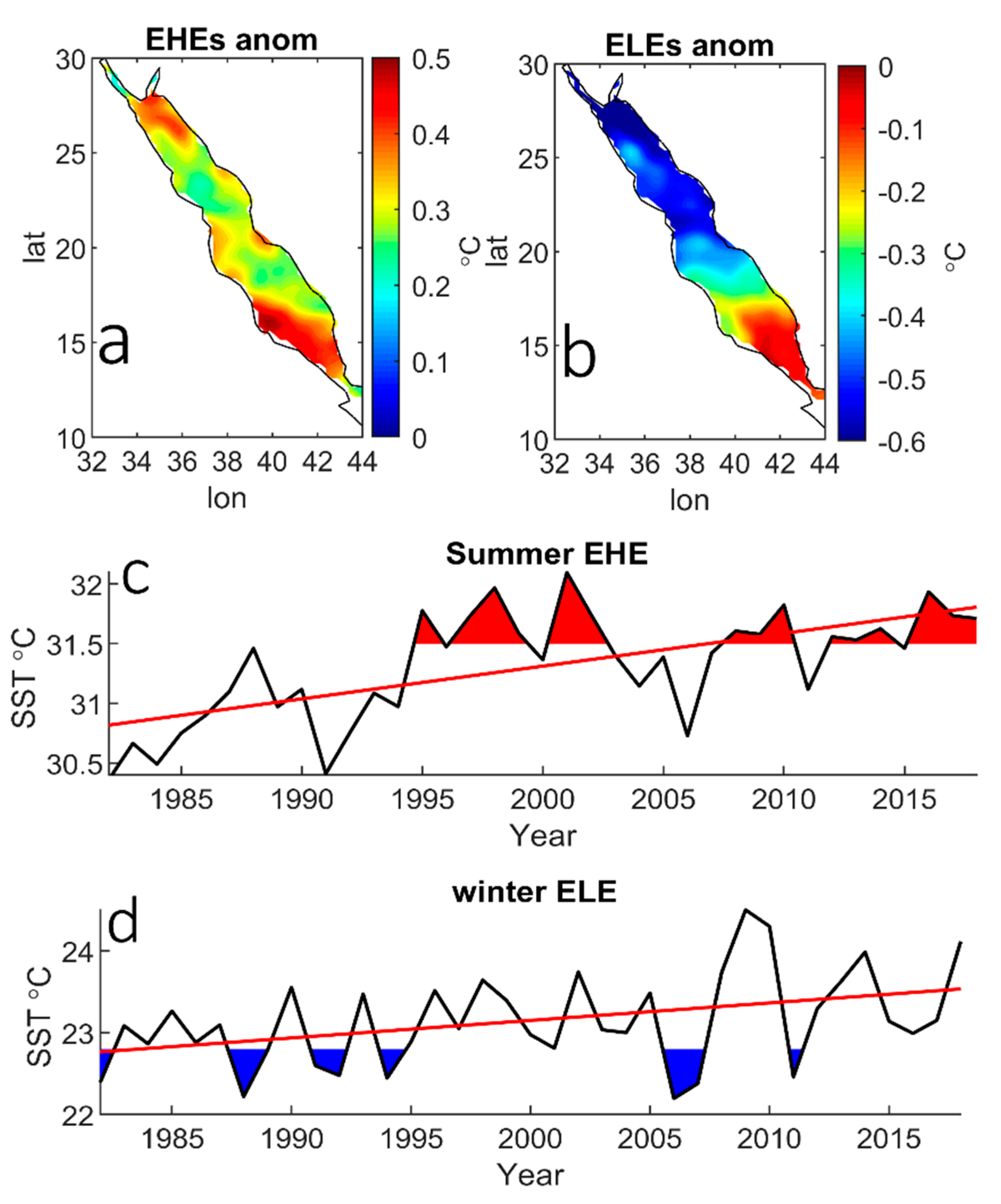

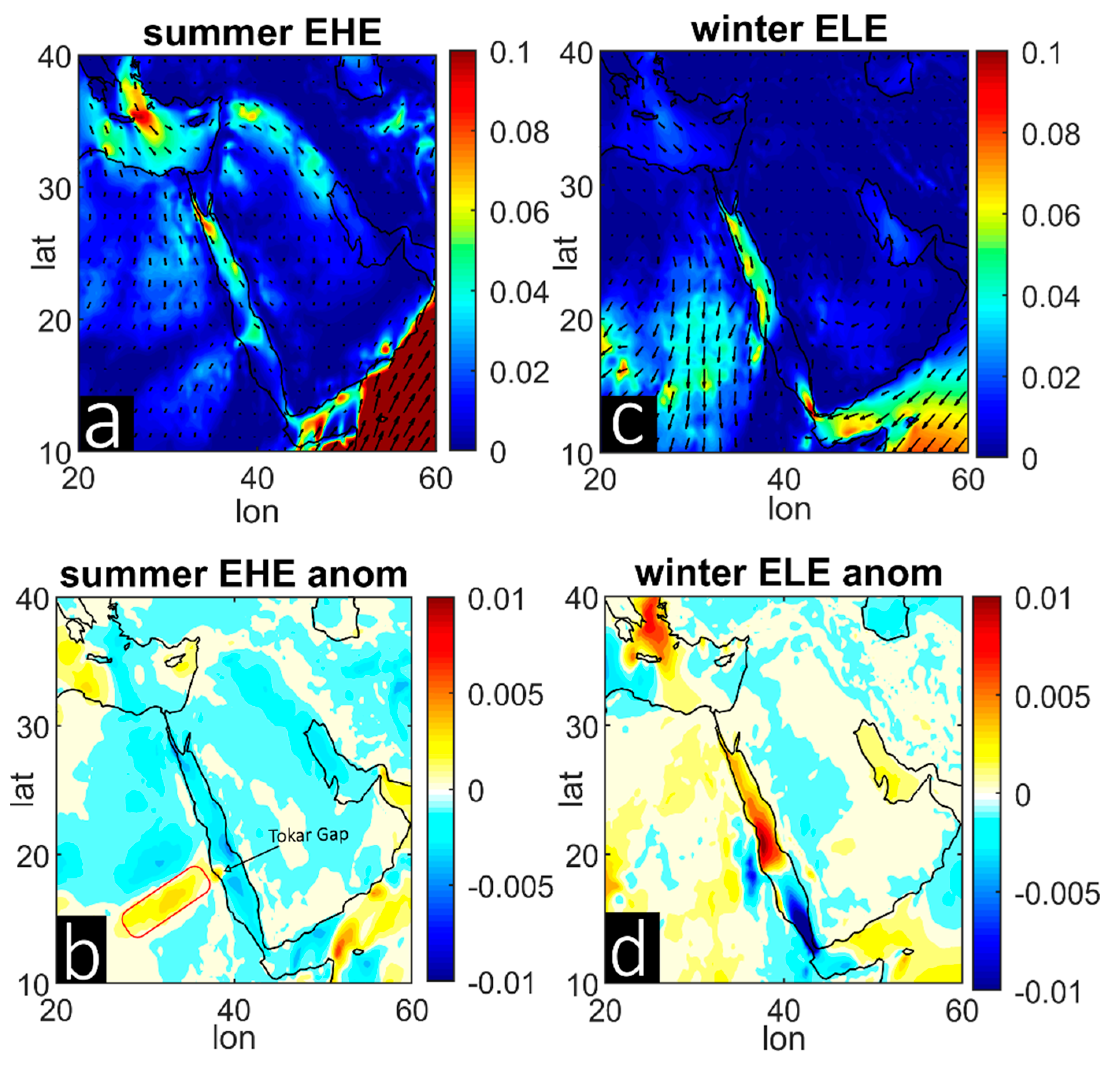
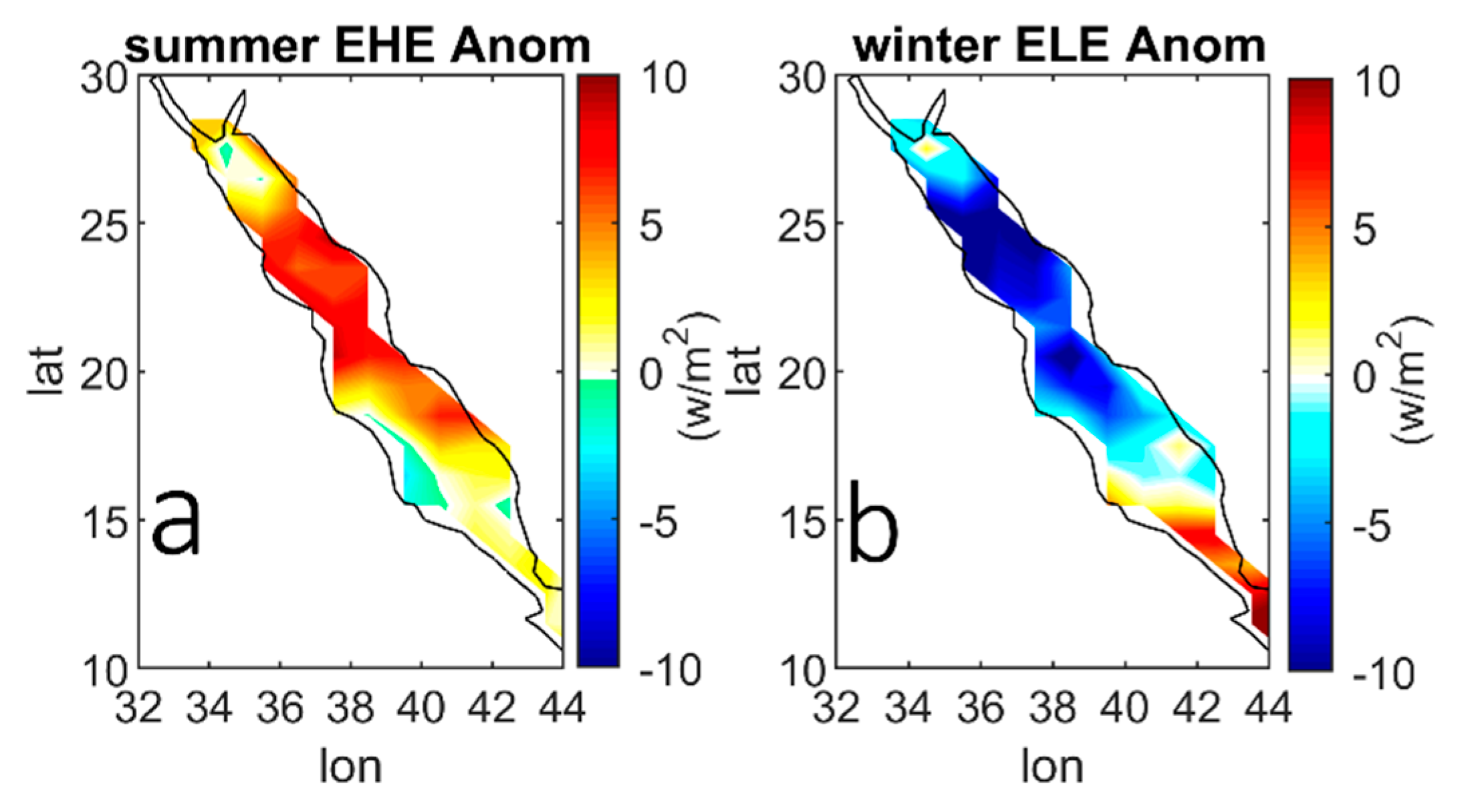

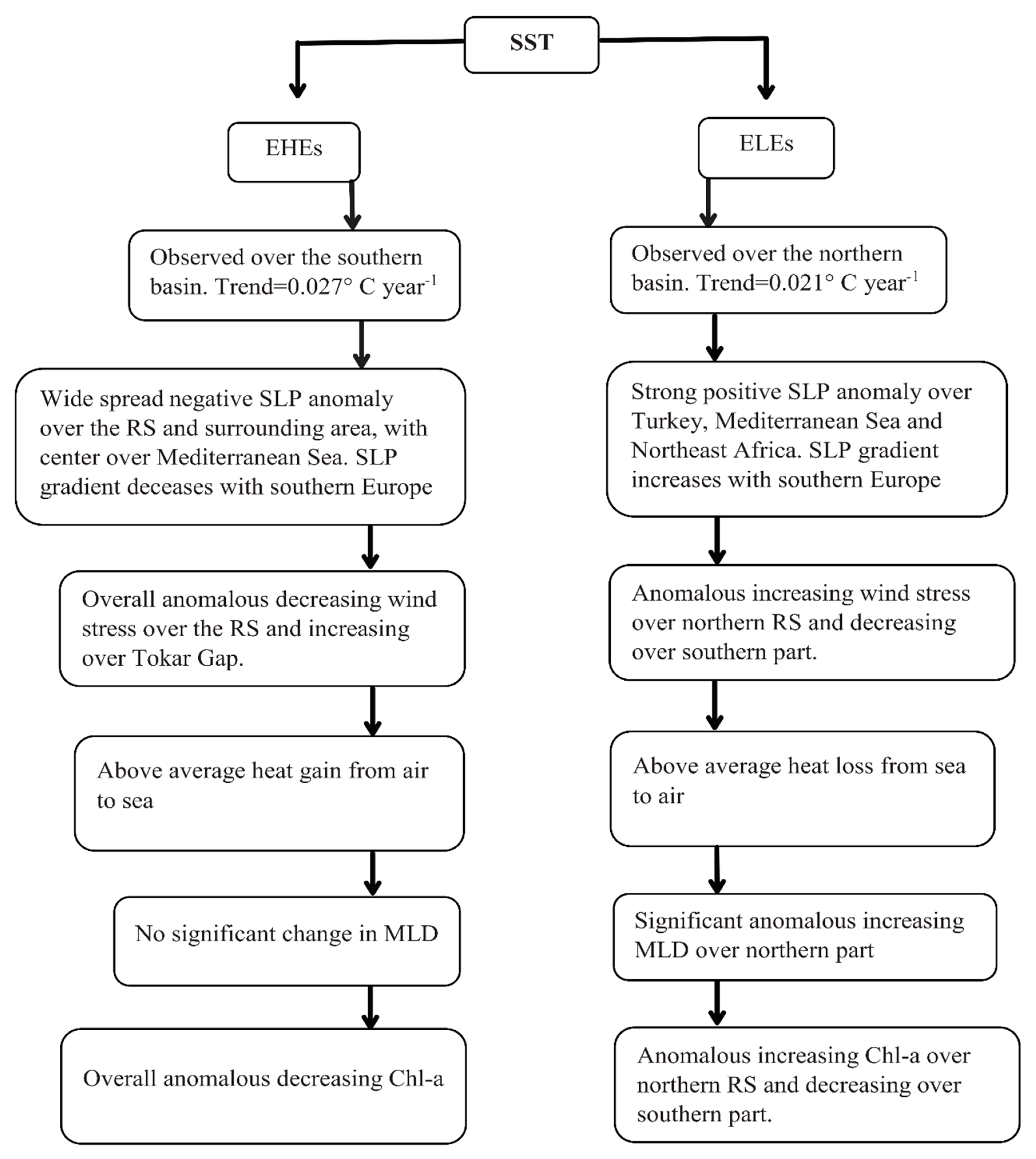
| Winter ELEs | Summer EHEs |
|---|---|
| 1982 | 1995 |
| 1988 | 1997 |
| 1989 | 1998 |
| 1991 | 1999 |
| 1992 | 2001 |
| 1994 | 2002 |
| 1995 | 2008 |
| 2006 | 2009 |
| 2007 | 2010 |
| 2011 | 2012 |
| - | 2013 |
| - | 2014 |
| - | 2016 |
| - | 2017 |
| - | 2018 |
| 10 | 15 |
© 2020 by the authors. Licensee MDPI, Basel, Switzerland. This article is an open access article distributed under the terms and conditions of the Creative Commons Attribution (CC BY) license (http://creativecommons.org/licenses/by/4.0/).
Share and Cite
Alawad, K.A.; Al-Subhi, A.M.; Alsaafani, M.A.; Alraddadi, T.M. Atmospheric Forcing of the High and Low Extremes in the Sea Surface Temperature over the Red Sea and Associated Chlorophyll-a Concentration. Remote Sens. 2020, 12, 2227. https://doi.org/10.3390/rs12142227
Alawad KA, Al-Subhi AM, Alsaafani MA, Alraddadi TM. Atmospheric Forcing of the High and Low Extremes in the Sea Surface Temperature over the Red Sea and Associated Chlorophyll-a Concentration. Remote Sensing. 2020; 12(14):2227. https://doi.org/10.3390/rs12142227
Chicago/Turabian StyleAlawad, Kamal A., Abdullah M. Al-Subhi, Mohammed A. Alsaafani, and Turki M. Alraddadi. 2020. "Atmospheric Forcing of the High and Low Extremes in the Sea Surface Temperature over the Red Sea and Associated Chlorophyll-a Concentration" Remote Sensing 12, no. 14: 2227. https://doi.org/10.3390/rs12142227
APA StyleAlawad, K. A., Al-Subhi, A. M., Alsaafani, M. A., & Alraddadi, T. M. (2020). Atmospheric Forcing of the High and Low Extremes in the Sea Surface Temperature over the Red Sea and Associated Chlorophyll-a Concentration. Remote Sensing, 12(14), 2227. https://doi.org/10.3390/rs12142227





